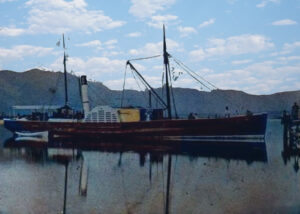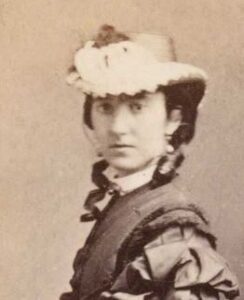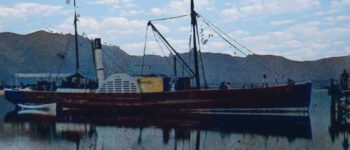1863: The Waka Buster
November 1, 2024
By AHNZ

Today in New Zealand history, 1 November, 1863 the Government’s streamer Lady Barkly set out from Onehunga on a capture/destroy mission on Manukau Harbour. The target was any and all uncontrolled transport craft, particularly Maori canoes: “Waka.” The crew returned on 6 November with 11 canoes in tow as well as a big stern post of war canoe Te-Toki-a-Tapiri which is today the prize of Auckland War Museum.
Next day after returning, Lady Barkly steamed off for another expedition. After 8 days even more canoes are seized or destroyed and Maori raiders chased away. New Zealand was at war, Auckland in the process of being invaded by ‘King’ Potatau Te Wherowhero who had gone from its protector to its greatest threat. Ref. 1863: Oath of Betrayal, AHNZ
On 9 July Governor George Grey issued a declaration of war in the form of his Oath of Alligence to Queen Victoria. Thankful for this very generous warning, a massive and orderly convoy of Maoris with their property set out south to join the new kingdom. King Potatau issued his own proclamation which included advice on how to loot a defeated enemy. The start of the Waikato War was quiet for many weeks while all the pieces were placed. Ref. 1863: Affair At Mauku, AHNZ
S.S. Lady Barkly (image left) was one of those pieces and its Waka Busting missions some of the first and most necessary acts of war. As the Daily Southern Cross newspaper pointed out, these captured paddle boats were capable of moving thousands of fighting men per trip. The day before, 31 October, General Cameron had begun the Siege of Meremere. The counter-invasion was on and it was imperative that Auckland’s vulnerability by water be checked. Lady Barkly’s mission was coordinated with Cameron’s strike and essential to the capital city’s security. On the other hand, she might have started sooner had Barkly not been stuck in mud soon after her maiden voyage, to Drury, on 26 October 1863.
On the first mission none other than famous Auckland businessman Josiah Firth was pressed into service on Lady Barkly. He wrote, “One morning I and my groom were summoned ‘on active service’ to capture the Maori canoes…Every able-bodied man had to go. The force, consisting of one hundred men, was under the command of Captain Lloyd, formerly an officer in the Irish constabulary, a little mad perhaps, but as gallant a leader as ever men followed. We captured a great many canoes of various sizes…” Ref. Nation Making, a Story of New Zealand, Josiah Firth (1890;) Te Toki a Tapirim, Timespanner (2011)
“We captured a great many canoes of various sizes, from the Kupapa (little canoe) to the Wakataua, (large war canoe)..A few old Maories, men and women, sat and watched the work. Arms were piled, and sentries posted, the latter precaution being unnecessary, for in accordance with the custom of the time, all the men of fighting age were off to the war, the old men and women staying at home to hold onto the land. An hour’s hard work put the big canoe in the little bay ready to be towed by the steamer on her return up the harbour. A week’s cruising in the attendant little steamer, with some hard marching, enabled us to capture all the canoes in the gulf, which, with the exception of the great war canoe were all subsequently destroyed. This war canoe now lies at the Auckland Museum.” Firth, Timespanner (2011)
“Built as a paddle steamer in 1861 by George White at Williamstown, Victoria,..purchased by the NZ Government in 1863 as an unarmed troop carrier for duty during the Waikato campaign…primarily used to seek and destroy Maori canoes which might be used to transport an invading force, and for ferrying men and supplies between the Manukau and the Waikato Heads. Her maiden voyage, to Drury, took place on 26 October 1863, but she ran aground on the return trip to Onehunga and was stranded for a fortnight before being freed. Soon after, she was used to capture a number of natives camped between the Manukau Heads and Waiuku, returning to Onehunga with her captives…A gun was added to her armament, allowing her to shell all fortified positions on the Waikato riverbanks. Following the conclusion of the Waikato campaign, she was laid up on the Manukau mudflats until she was acquired by the Red Cross Line in 1867 for employment on a service linking Nelson, Waitapu and Collingwood, a run she maintained for the rest of her career until she was broken up on Haulashore Island, Nelson, in 1934.” – The Ultimate New Zealand Soccer Website
“The Lady Barkley had an interesting history. From the private yacht of Governor Barkly, Australia, she became a gunboat for the New Zealand Government and operated in the Maori Wars on the Waikato River. Later she was bought by Pilot Cross, Nelson, and operated as a passenger and cargo vessel between Nelson and Golden Bay. She was later changed from a paddle steamer to screw.” – Nelson Photo News (1962)
“These canoes alone would transport 1,000 men. They were captured in a few of the creeks on the Western arm of the Manukau, from Tuesday morning until Thursday. We do not suppose there are nearly all the canoes which are lying snugly hid in the almost innumerable creeks of this inland sea. Many of those captured were lying drawn up on the banks and so concealed as to escape any but an extremely close scrutiny..” – Daily Southern Cross (1863,) Papers Past
“At the close of the Maori Wars the little steamer lay for a long period on the Manakau mud-flats, until in 1867 she was steamed to Nelson by Captain J. S. Cross Junior where in due course she was put into service between Nelson, Waitapu and Collingwood, as mentioned earlier. The Barkly thus became a unit of a small fleet of steam and sailing craft owned by Captain Cross under the title of the Red Cross Line. At the beginning of her career as a trader the vessel was subsidised by the Nelson Trust Fund, but this arrangement ceased in 1869.” – Marine News ( Vol 20 Issue 04, 1969,) NZ Ship and Marine Society
“During his government of Victoria constitutional questions of some delicacy cropped up in connection with the initiatory stages of responsible government in that colony, but on the whole his régime was popular and respected.” – Barkly, Sir Henry. The Dictionary of Australasian Biography, Philip Mennell (1892)
Barkly carried on as a supply ship and even a gun ship but after the war somehow became discarded. Or, perhaps I shouldn’t say ‘somehow’ as this was government property and so it’s perfectly normal in the course of things that it would become abandoned and go to waste. Laid up on the Manukau mudflats, this wooden boat was apparently “full of mud” until a Nelsonian rescued her¹ and took her home with him for a new life. James Smith Cross, Harbourmaster and pilot of Nelson, created a mild sensation in Nelson when he purchased a vessel lying in Manukau Harbour full of mud. This was the Lady Barkly. for many years “the pride of Port Nelson.”” Ref. Nelson Evening Mail (1939,) Papers Past
After being a great asset and a long life for the people of Nelson, and a temporary name change to Hina, the Barkly sat in Nelson mudflats before finally being deregistered on New Years Eve 1934. However, it’s curious to speculate about her early days and where the name came from. Prior to becoming a New Zealand ship she was an Australian and has an Australian name. She was named after the wife of the Governor of Victoria Henry Barky’s second wife: Anne Maria Pratt. According to the Nelson Photo News the ship’s Australian life was as the Barkly’s private yacht.
 The Victorian government was friendly and helpful to George Grey’s Maori War. Our government even had a recruitment office at the Port Phillip Club in Melbourne’s Flinders Street. After the gold rush the Victorians needed to do something with their surplus people and Grey wanted them as fighters then settlers. Dean Pitt appears to have been responsible for the entire equipping and recruiting program which included getting the men back to Auckland. We may reasonably surmise that Pitt and his team also procured Barkly’s yacht which led to the retention if not the creation of its honorific name. The Barkly name would bring glory to the Governor if the war went well and keep him invested if things got choppy. It being an in-house government-to-government deal it may even be that the Gov’ received a better-than-market price for letting go of his new 1861 craft to sweeten the military alliance. Besides, the Barklys were leaving Australia behind for a new Governorship (his 4th) so didn’t need their old toys.
The Victorian government was friendly and helpful to George Grey’s Maori War. Our government even had a recruitment office at the Port Phillip Club in Melbourne’s Flinders Street. After the gold rush the Victorians needed to do something with their surplus people and Grey wanted them as fighters then settlers. Dean Pitt appears to have been responsible for the entire equipping and recruiting program which included getting the men back to Auckland. We may reasonably surmise that Pitt and his team also procured Barkly’s yacht which led to the retention if not the creation of its honorific name. The Barkly name would bring glory to the Governor if the war went well and keep him invested if things got choppy. It being an in-house government-to-government deal it may even be that the Gov’ received a better-than-market price for letting go of his new 1861 craft to sweeten the military alliance. Besides, the Barklys were leaving Australia behind for a new Governorship (his 4th) so didn’t need their old toys.
Anne Maria, The Lady Barkly, apart from being the Govenor’s 25yo wife, was daughter to Major General Thomas Pratt. He had been Commander of the British Forces in Australia and then New Zealand too; The military brains behind the Imperial Force in the Taranaki War. Lady Barkly’s Dad was knighted by Governor Barkly himself in the first ceremony of its kind performed in Australia. Ref. Wiki
According to the Encylopedia of New Zealand (1966,) “That the Home Government shared his views was shown a few months later when Pratt was created K.C.B. specifically for his services in New Zealand.” But perhaps we should look deeper into the KCB and wonder it was really Imperial approval or a Victorian Governor going a bit rogue for his new father-in-law? Ref. McLintock (1966)
Governor Barkley was, after all, known for exacerbating what the Dictionary of Australian Biography mildly referred to as “constitutional questions.” And it was he who created the Victorian Navy which is how General Thomas Pratt and his staff were to New Zealand in 1860. Same year Barkley married Pratt’s daughter. Ref. 1860: Victorian Navy Deployed to New Zealand, AHNZ
In a story reminiscent of My Granfather’s Clock, Lady Anne died in 1932 and SS Lady Barkly deceased at about the same time and officially so within 2 years. Like the clock in the song she stood for 90 years (+) but in addition was a noted botanist².
Looking at the history of this long gone steam ship through an Anarchist History lens rather than a Government History lens has generated a few curious leads. It seems as if there might be, once again, more to our New Zealand history that is owed to Australian power elite families than our mainstream history books have been interested in revealing.
2 Mind you, there is a trend toward DEI (Diversity, equity, and inclusion) in history these days so it’s hard to tell if Anne really was a scientist or if she has been forced into the ranks to do something nice for ladies representation…
Image ref. “Lady Barkly”. Nelson Provincial Museum, Nelson Historical Society. AHNZ enhanced (2024)
Image ref. Lady Anne Maria Barkly (age 25 in 1863,) National Portrait Gallery, Canberra. Art Blart. AHNZ cropped
 Like Comment Share
Like Comment Share





